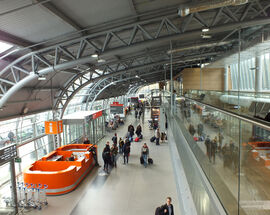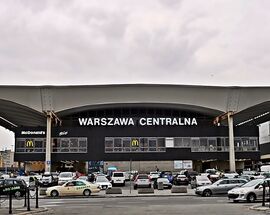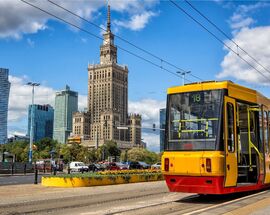While Warsaw is generally well linked with both the outside world and the rest of Poland, both road and rail networks have all undergone major regeneration work (in part thanks to Warsaw's hosting of the Euro 2012 football championships). The city's two major airports have also recently undergone major renovations and now arriving in Warsaw is as streamlined as it's ever been.
By Plane
Getting in and out of Warsaw by plane improved drastically in recent times. The capital's main air hub - Chopin Airport - got a modern overhaul, while budget carriers moved in at Modlin Airport just north west of the city.Chopin is decidedly easier to get to, with buses and trains that take you straight to the arrivals gate. For buses, head out of the arrivals gate and cross the pickup zone to the bus stop. There, grab the 175, which takes you right to the center of the city. For trains, go the train station (downstairs and to the south -- there's a big sign saying Stacja Kolejowa) grab the S2 or the RL. Uber is also a popular option, and there is a place to pick up your Uber right outside the arrivals gate.
Modlin is a little more difficult, but there are buses with Flixbus or Contbus that take you right there (you just need to plan ahead and schedule the ride). Of course there's always the train, too. Take the Modlin Airport shuttle bus (it's right outside -- and Modlin is a small airport so it's easy to find) to the Modlin Train Station. From there, you can take the RL into the city. It will take about an hour, but so will a taxi.
If you just don't want to deal with public transit, there are other great options. Of course, you can rent a car at Chopin. But, for a price, you can also take Warsaw Mr. Shuttle, or Talixo, or WawaBus. See our "Getting Around" section for still more options.
Airlines
- Adria Airways
- Air France
- Alitalia CAI
- American Airlines
- Austrian Airlines
- Belavia
- British Airways
- Brussels Airlines
- CSA
- Finnair
- KLM
- LOT
- Lufthansa
- Luxair
- SAS
- Swiss
- Wizz Air
Modlin Airport Transfers
Stuck the tin can-esque airport (Modlin) in a forest somewhere in Poland? Have no fear, there is a large selection of services to choose from so have a look and choose wisely. Also don't forget to check out the "by Bus" and "by train" sections below, as well as the Modlin Airport page for even more options.By Train
Warsaw's main train station, Centralna, is a hulking metal giant that sits conveniently in the city's centre and is the main hub for trains arriving in the capital. Additionally, passengers may disembark at the smaller Warszawa Wschodnia (Warsaw East station) between Praga Północ and Praga Południe districts, and Warszawa Zachodnia (Warsaw West station) on the border of Ochota and Wola districts. There are plenty of other train stations throughout the city but these are the big three!Don't forget to take a look at our train smarts page for some insider tips on what to do when you get on a train, easiest ways to buy tickets and more!
- Warszawa Centralna Train Station
- Warszawa Gdańska Train Station
- Warszawa Wileńska
- Warszawa Wschodnia Train Station
- Warszawa Zachodnia Train Station
By Bus
If you come to Warsaw by bus, odds are you'll be landing at the main bus station on Al. Jerozolimskie, while budget options like FlixBus drop passengers off a short distance from Metro Młociny.Buses run all over the city and can be caught from pretty much everywhere. See more on our Public Transport page. For now, here are some of the main bus depots and two buses that will drop you in Warsaw from anywhere (within reason)!
- Aura
- Flixbus
- Main Bus Station
- Metro Wilanowska Bus & Metro Station
- Młociny Bus, Tram & Metro Station
By Car
Warsaw is located in the heart of the country and has extensive road links with other major Polish cities. Having said that, the competition on the road front isn't fierce. Roads leading into Warsaw tend to be of decent dual carriageway standard, though once you enter the city limits Warsaw traffic can become a serious problem - particularly during the week. Most major hotels are located in the central area and you should be heading in most cases for the Central Train Station (Dworzec Warszawa Centralna) and its neighbour, the Palace of Culture (PKiN). Parking in the central area is generally available on-street where there are standard parking charges payable at roadside machines. Most major hotels will offer some form of off-road guarded parking.The speed limit is 50km/hr in cities (60km/hr between 23:00 and 05:00), 90km/hr outside urban areas, 120km/hr on dual carriageways and 140km/hr on motorways. Seat belts must be worn at all times and it is illegal for drivers to use hand-held mobile phones. Following the letter of the law all cars should be equipped with a first aid kit, warning triangle, fire extinguisher, rear mud flaps and right and left hand outside mirrors. Flouting the rules will cost you 200zł (for using a mobile), 100zł (not wearing a seat belt) and up to 2500zł for speeding! The legal limit for drink driving is 0.02% blood/alcohol level. (That's so much lower than the US and many other countries.) For the most part, Poles will not drink a sip if they plan to drive. Many people actually don't drink the night before they have to drive, either.
Put simply, if you’re driving, don’t drink.
EU citizens may use their home driving licenses as long as they are valid, however citizens of countries that didn't ratify the Vienna Convention (tsk, tsk Australia and America) will find their licenses invalid (though that hasn't stopped anyone we know from driving their girlfriend's car). Carry your license and passport at all times when driving.
Since April 2007 it has been compulsory for headlights to be switched on at all times.


 [CC BY-SA 3.0_m.jpg)




